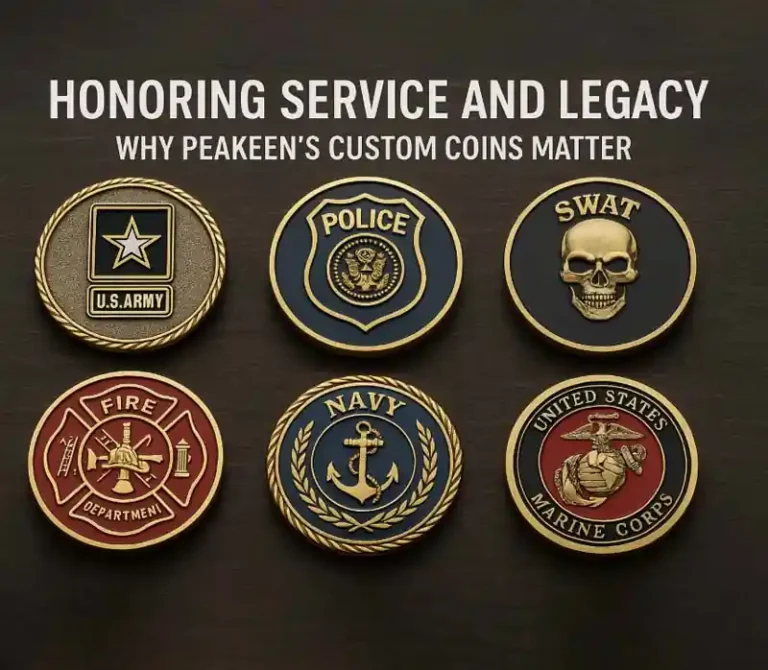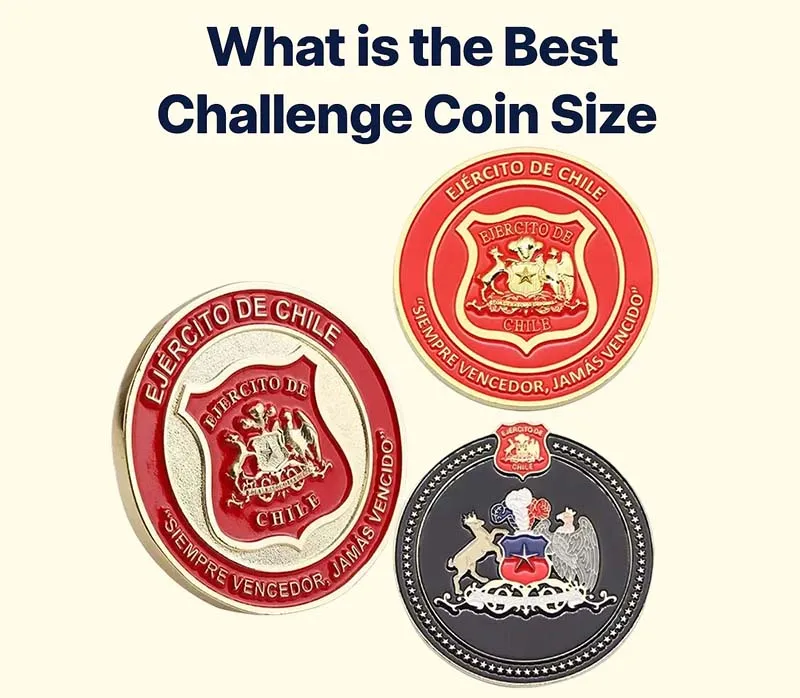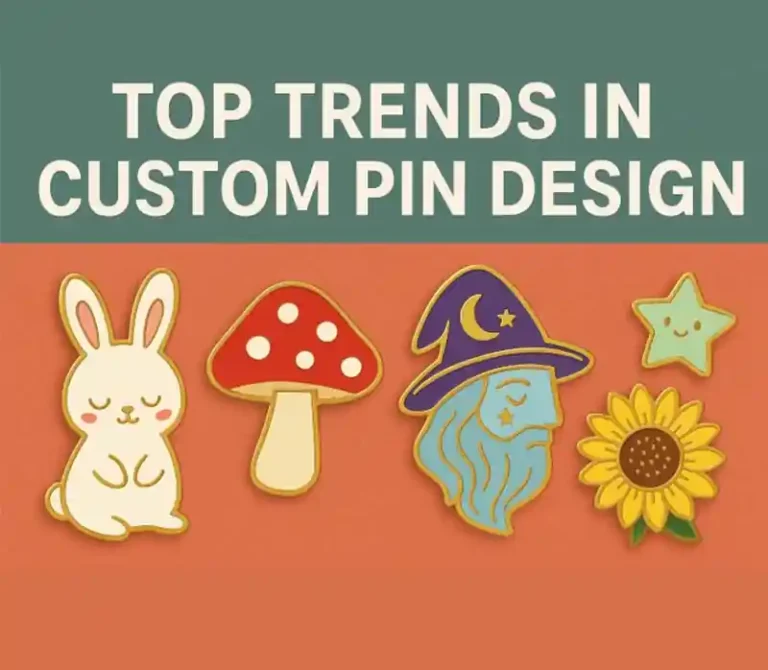
Top personalisierte Militärmünzen: Erstellen Sie noch heute Ihre einzigartige Hommage
Table of Contents For centuries, challenge coins have been a symbol of unit solidarity and historic achievement within the armed

Challenge coin size differs, but most coins tend to be anywhere from 1.5 to 2 inches in diameter and around 0.1 inches thick.
These measurements make them easy to carry around while providing room for detailed artwork. They may vary in size depending on their function or the body issuing them.
Custom coins can be different sizes so as to make for a unique design or add importance. Knowing these measurements allows us to respect their art and utility.
Challenge coins are available in multiple sizes. The dimensions of a coin influence not just its appearance, but its usability and convenience. Knowing the common dimensions will assist in selecting the appropriate coin for your particular requirements – personal or organizational.
Standard Sizes: Most challenge coins range in diameter from 1.5 inches to 2 inches. These sizes have become somewhat of an industry standard because they provide a nice balance between portability and design space.
1.75 inch coins tend to be particularly sought after, providing a compromise somewhere in the middle that caters to intricate designs without becoming cumbersome.
Round shapes rule the market, because they are classic and versatile. Their symmetry makes them perfect for adding logos, emblems, or text—which helps keep designs visually balanced.
Non-standard shapes such as hexagons or dog tags are picking up steam for those looking for something unique.
Practicality drives the preference for smaller coins, usually under 1.5 inches. These coins slide effortlessly into wallets, pockets or tiny compartments, making them a practical option for carrying around on a daily basis.
This portability is oftentimes cherished by those who want to have their coins conveniently nearby for personal meaning or rapid display.
More substantial coins—typically over 2 inches in diameter—are selected because they can show complex designs. The extra surface area gives room for intricate art, like 3D sculpting, complicated designs, or multi-colored enamel finishes.
These coins are often reserved for commemorative or high-ranking military awards, where aesthetics and design flair are paramount. Although these coins may not have the same portability, their bolder look typically makes them shine as a focal point in a collection or display.
Choosing the size of your challenge coin is an important decision. The size dictates not only the coin’s aesthetics but its utility, price, and intent. This is a process where a checklist can help guide this process by breaking it down into manageable steps and making sure you’re considering every factor.
Start by considering the raison d’etre of the coin. If you want a coin to carry daily–a token of recognition, or a little keepsake–then they most often work best in a standard size of approximately 1.5 to 2 inches across.
These sizes balance portability with demonstrating complex designs. Display coins, such as commemorative items, however, can be 2.5 – 3 inches or bigger. These bigger coins provide a greater surface for more intricate designs and inscriptions.
Next, think about the design detail. As it turns out, smaller coins tend to restrict how much detail you can cram onto the coin. For instance, 1.5-inch coins work well with basic logos or icons.
However, if you’re adding text or intricate designs or multiple layers, then you’ll want to opt for a bigger size. Remember, design software will scale components to fit your selected size, but size does matter.
Budget considerations should factor into your decision. Bigger coins are usually more expensive to produce because they use more materials, cost more to ship, and require more intricate engraving.
A clever solution could be to make a mini coin with premium finishes (enamel/plating) to give it that high-end feel without the high-end price. For instance, a 2″ coin with a polished gold plate often seems just as elite as a 3″ coin.
Last but not least, consider practicality versus aesthetics. A coin that’s too big is a pain to carry around, while one that’s too small doesn’t feel like it has any weight to it.
If you’ll be carrying the coin in a pocket every day, something on the order of 1.75 inches might be the ideal balance. Working with a professional design team can help guarantee that the coin’s size doesn’t thwart your goals without compromising function or aesthetic.
Designers can present 3D renderings or samples so you can get a sense for how the end product will appear or feel.
Size is a big part of what gives a challenge coin meaning and emotional clout. These coins are more than just objects — they’re often sized to represent a deeper meaning related to the occasion, group or person they commemorate. Tiny and subtle or giant and imposing, the size of a challenge coin can affect how it’s received and treasured.
Coin Size | Symbolism and Significance |
|---|---|
1.5 inches | Compact, minimalist design; symbolizes subtlety and practicality. |
2 inches | Balanced size; often used for general purpose or broader appeal. |
2.5 inches or larger | Grand, eye-catching; conveys prestige and high importance. |
Smaller coins, usually about 1.5 inches in diameter, tend to be selected for their subtle glamour. Their small form factor makes them portable to the point of pocket- or wallet-sized, which keeps them close to the receiver. Tiny as these coins are, they can be enormous in sentiment.
For instance, an army regiment could distribute tiny coins, representing the brotherhood and bonds forged in the battlefield, highlighting minimalism and individuality.
On the other side of the spectrum, bigger coins—frequently 2.5 inches and up—are all about making a statement. These coins are generally for marking some accomplishment or event. Their dimensions provide room for more intricate designs and detailed artwork, which can consist of engraved text, logos or even 3D elements.
For example, a big coin could be awarded by a company for years of service.
The link between coin size and significance of the occasion it commemorates is unbreakable. A coin allotted for a once-in-a-lifetime achievement, such as a career benchmark or a historic moment, tends to favor a bigger size to match its weight.
At the other end, smaller coins could be used to reward more frequent or casual acknowledgements – like participation in a community event. The size selection conveys, even subliminally, the significance of the moment.
Nothing says memorable like a perfectly-sized challenge coin. The sizes need to connect with the intent of the coin. For instance, a 2-inch coin strikes the perfect balance between portability and presence, which is why it’s a common go-to for versatility.
Size doesn’t matter — the important thing is that it’s substantial-feeling in the hand, so that it serves as both a trophy and a memento.
Size is probably one of the most important things to consider when designing a challenge coin as it affects the coin’s look as well as the coin’s function and price. The size of a coin physically limits the amount of detail that can be included — so all design constraints must be considered. Every choice, from the coin’s diameter to the edge style, is a key element in finding a balance between beauty and usability.
Smaller coins inherently limit the amount of information that can be displayed. Consider, for example, that a 1.5-inch coin offers significantly less surface area than a traditional 2-inch coin — there’s simply less space for complex designs, detailed logos or long text. This limitation frequently compels designers to pare their designs down to the bare minimum. For instance, a military unit coin may be forced to put its insignia ahead of extra mottos or dates if space is scarce.
Conversely, though, larger coins, though more creative, can seem bulky or too heavy for use.
Balancing Complexity and Surface Area: Regardless of size, there is an undeniable need to align Design-Komplexität with the available surface area. Just as too many words or designs on a coin makes the details feel crowded or unreadable. For instance, a coin for a corporate event may feature a company logo, slogan and date, but you don’t want to add so many decorative features that it becomes unclear.
Designers typically employ strategies such as different relief depths or selective plating to craft depth and contrast without cluttering the coin’s surface.
Custom Shapes and Unique Edges: Custom shapes and non-standard edges add another layer of complexity to the design process. Although the classic round coin is the standard, hexagons, dog tags or cutout designs can offer more creative freedom and can redefine what ‘size’ and proportions mean.
While a 2-inch round coin may seem roomy, a 2-inch star-shaped coin will have more restrictive usable areas around its points. Likewise, edge designs, be they rope designs or reeded finishes can visually frame the coin but minimize the amount of space you have for center artwork.
Custom shapes and features. Although classic round coins are eternal, a lot of clients opt for custom shapes to differentiate themselves. Customized shapes or enhancements, like bottle openers or cutouts, are a different story and need special molds and extra work, which drives up production time and costs.
Numbers game. The quantity of coins you order greatly impacts economy of scale. Typically, bigger is better, cost per unit-wise. You see, if you ordered 500 coins instead of 100, your price per coin would be substantially less because the fixed setup costs for molds and equipment are amortized over more units.
It’s important to balance quantity with purpose because stocking up too much might end up costing you. Bulk orders of regular-sized coins tend to get made quicker than small batches of custom stuff, which makes them great for last minute or high volume needs.
Complex color challenge coins are often generated using a printing process that will effectively reduce production time without compromising presentation
With challenge coins, size is not only about measurement – it’s a delicate dance between form and function. Although diameter is often the focus, thickness, weight, and even feel can be a major contributor to the coin’s desirability. These factors, while less obvious in initial inspection, deeply influence the coin’s function, style, and impact.
The thickness of a challenge coin influences its heft and longevity, which establishes a balance between the three. A thicker coin, meanwhile, typically has a nicer heft and can’t be easily bent or worn down — something that’s definitely not ideal for coins designed to commemorate an accomplishment.
Thickening something adds weight, and you might not want a coin that’s too heavy to carry. For reference, here’s how these factors relate:
Dicke | Weight | Dauerhaftigkeit |
|---|---|---|
Thin (1.5mm) | Lightweight (~0.5 oz) | Lower resistance to bending |
Medium (3mm) | Moderate (~1 oz) | Balanced durability |
Thick (5mm) | Heavy (~2 oz) | Highly durable |
It’s this equilibrium that makes the coin not only visually arresting, but durable enough to last.
Whether a challenge coin is too big, too small, or too heavy can make or break its practicality. Coins that are too large or heavy look great but are unwieldy to lug around in a pocket or wallet.
For instance, 2-inch diameter and medium weight coins are popular with collectors and organizations alike because they tend to be just the right size — small enough to be easily carried but large enough to feature beautiful detail.
On the other hand, coins larger than 3 inches in diameter are better for display than for everyday use since their size tends to restrict portability.
Size is important when it comes to whether a challenge coin fits into cases, racks or other storage items. Typical sizes for coins like these, like 1.75 or 2 inches are selected, in part, because they fit nicely into standard cases, allowing the coin to rest securely without appearing too large or small.
Custom sizes could necessitate custom storage, a drag for collectors.
Beyond measurements, the weight of a coin in hand is the unseen element. A nicely weighted coin with a comfortable heft is a wonderful feel and makes it feel even more valuable.
Coins that are too light can seem trivial and coins with lopsided weight distribution feel awkward to hold and take away from their allure.
Challenge coin size isn’t just dimensions, it’s symbolism. Your sizing selection defines the design, the tactile experience, and the impact it makes. Tiny coins slide into pockets and the big ones demand respect. Each option has its own trade-offs, from manufacturing expenses to design specifics. It’s a dance between the inspired and the pragmatic.
Consider what means most. Is it convenience? Eye candy?) A particular message? Every choice has a narrative. That’s the right size, it ties the design with the purpose and that’s what makes the coin memorable.
If you’re designing your next challenge coin, slow down. Balance your decision. The right size could end up being exactly the size that fits its tale—and its mission.
Die typical challenge coin measures 1.75 inches in diameter. They don’t come in uniform sizes either, typically in the 1.5″ to 2″ size depending on design and intent.
Yes, challenge coins can be any size! For the most part, designs hover in that 1.5 to 3 inch range due to practicality and portability.
Indeed, bigger coins are typically pricier because of the additional material and manufacturing requirements. Smaller coins are generally more affordable, yet provide intricate designs as well.
Our 2” coin is perfect for intricate designs. It’s just large enough to allow for detailed designs, but not so large that it’s cumbersome to transport.
There’s no firm size limit, but the majority of coins are 1.5 to 3 inches. Too large of coins can be cumbersome to create and carry.
Bigger coins are heavier because they use more metal. For instance, a 2 inch coin is heavier than a 1.5 inch coin, and this may impact how easily you can carry it.
Design complexity, budget, and usage to name a few. Small coins are more convenient to carry, but large coins provide more area for intricate artwork or copy.

Table of Contents For centuries, challenge coins have been a symbol of unit solidarity and historic achievement within the armed

Table of Contents Custom lapel pins and custom pins are more popular than ever! They are a fantastic, tangible way
Nr. 5, Tongan Road,
Ostbezirk Xiaolan Town,
Zhongshan, Guangdong,
China
Urheberrecht © 2024, Zhongshan Peakeen Gifts Supply Chain Co., Ltd. Alle Rechte vorbehalten. Angetrieben von PeaKeen Datenschutzerklärung
Lassen Sie uns zusammenarbeiten, um Geschäftswachstum zu erzielen!
Lassen Sie uns zusammenarbeiten, um Geschäftswachstum zu erzielen!
10% Aus